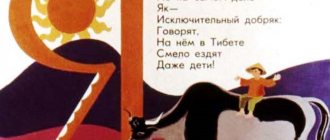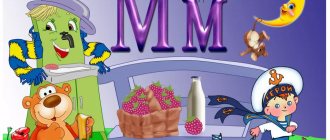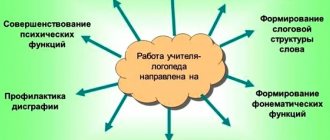Where do smart children come from? Why does one child do better at school than another? Psychologist Anna Bykova, author of the book “Developmental Activities for a Lazy Mom,” knows the exact answer to this question. The whole point is how often the simplest games were played with a child at 1-2 years old, which forced him to keep his attention. Try it - and in 5-6 years we will evaluate the result! In addition, these attention games will help you keep your child occupied on the go and during unplanned waits.
What determines a child's learning ability? It is clear that heredity plays a role - and this is a factor that parents can no longer influence; what has come has come. But there are other factors that directly depend on the efforts of parents and grandparents. What can you offer your baby to help him be successful in school? Is it possible to influence this?
These questions concern not only parents, but also scientists. As usual, studies were conducted in which a direct relationship was established between the intelligence of children at 5 years old and at 10 years old. That is, children who showed high results in intelligence tests at the age of five showed the same high results at ten years.
But no such relationship was found with intelligence indicators at the age of 1–2 years: assessments of the baby’s intelligence did not correlate in any way with assessments at other ages. Why? Maybe they measured something wrong?
After lengthy research, scientists came to the conclusion that the development of intelligence is mainly influenced by the ability to maintain attention. Moreover, endogenous attention. That is, one that arises from within, through one’s own activity and will, and not just as a response to external stimuli.
Card index of didactic games
Modern preschool educational institutions operate in strict accordance with the Federal State Educational Standard for Preschool Education (FSES DO). The Standard states that preschool institutions must ensure the social, communicative, cognitive, speech, artistic, aesthetic and physical development of children (clause 2.6.). Therefore, when developing a calendar-thematic plan for educational activities, the educator must take into account the classes implemented in the form of DI. The thematic plan should include games that, in terms of their educational objectives, meet the requirements of the standard.
Table: card index of didactic games in junior groups
| Direction of child development | Name | Tasks | Description |
| Speech | "Wonderful chest" |
| The teacher takes out various objects from the chest (box), the children name the object or get acquainted with a new object. |
| "Lotto" |
| The teacher has illustrations of objects in the singular, and the children have similar pictures, where there are several objects. The child whose picture matches the one shown by the teacher says what is shown on it. | |
| Cognitive | "Matryoshka" | Form ideas about surrounding objects (shape, part and whole). | The teacher invites the children to perform various actions with the toy: examine, assemble, disassemble. |
| "Pyramid" | Form ideas about surrounding objects (shape, color, size, part and whole). | The teacher lays out several disassembled pyramids with multi-colored rings and mixes them. Gives each child a ring of the same size and color and instructs them to find an identical pair for their ring. | |
| Physical | “Let’s recognize the color and act!” |
| The teacher keeps and distributes objects of different colors to the children. Shows objects of one or another color. If the color of the object matches between the child and the teacher, the child performs an action (runs, jumps, etc.), if it does not match, then the activity does not occur. |
| “Empty Place” (version of the folk game) | Form strong-willed qualities and control over your behavior. | Participants run around the circle from different sides. The winner takes a seat, for example, a chair, the loser takes the lead. The driver chooses his partner. | |
| Social-communicative | “What did Parsley choose?” | To develop organization and mutual assistance in children. | The teacher alternately demonstrates the sounds of different instruments, then continues these actions, but behind a screen, the children guess which object makes the sound. |
| "Silent women" | Develop readiness for self-control. | After the command “silence” there is silence. If the child laughs, speaks or moves, he gives the presenter a forfeit. Forfeits are “buyed back” at the end of the game. | |
| Artistic and aesthetic | "Sea" |
| The music worker (teacher) performs a musical piece, the children talk about the feelings and emotions that arise in them, and share their impressions. |
| "Assemble a pattern" |
| Children collect pictures from fragments depicting folk crafts. |
Table: card index of didactic games in the middle group
| Direction of child development | Name | Tasks | Description |
| Speech | "Hot Cold" | Add antonyms to your active dictionary. | The teacher pronounces an adjective, and the child responds with an adjective with the opposite meaning. You can use a ball or other objects. |
| "The Beast and His Cub" |
| The ball is thrown from the teacher to the child, the throw is accompanied by the name of an adult animal, the child in response names the baby of this animal. | |
| Cognitive | "Guess the time of year!" | To form an idea of the planet Earth, its nature, the properties of objects in the surrounding world. | The teacher reads a text, a poem, a riddle about the seasons and asks the children what time of year they are talking about. |
| "Good bad" |
| The teacher voices a problematic topic (for example, snowfall). Children give their assessment of the phenomenon. | |
| Physical | "Gathering the Harvest" | Form motor activity, coordination, motor skills. | The teacher tells the children that they are gardeners, and the balls are fruits that need to be collected in baskets. Children take turns throwing “fruits” into the basket: “apples” with their left hand, and “pears” with their right hand. |
| "The Fisherman and the Fishes" | To form experience in motor activity aimed at developing coordination. | Fishermen try to capture as many fish children as possible with a net (rope). | |
| Social-communicative | "Let's say hello!" |
| The teacher and children talk about different ways of greeting both among people and among animals, come up with their own, and demonstrate them. |
| "Tell about yourself" |
| The child is asked to say his name, briefly talk about his hobbies, habits, etc. | |
| Artistic and aesthetic | "Finish the picture" | Develop fantasy and imagination through visual activities. | Objects are partially drawn in the pictures; you need to finish drawing and coloring the missing parts. |
| “Paint the handkerchief” |
| While playing, the child makes simple patterns from various decorative elements. |
Table: card index of didactic games for older preschoolers
| Direction of child development | Name | Tasks | Description |
| Speech | "Broken Phone" | Develop auditory attention and speech skills. | The teacher whispers a word to the child sitting next to him, who passes it to the child sitting next to him, etc. The last player names the word that he heard. Afterwards, the distortion of the original word is checked and the link where this occurred is determined. |
| "Third/fourth wheel" | Strengthen the ability to perceive information by ear and speech skills. | The teacher names the objects of the set and, among others, names an object that is not related to the given set; who notices an error, declares this, for example, by clapping his hands. | |
| Cognitive | “What do they plant in the garden?” | To develop the ability to classify objects in the surrounding world according to the designated criteria. | The teacher asks the children to answer in the affirmative if the object of the surrounding world he named is a garden plant, and vice versa. |
| "Houseplants" | To form ideas about planet Earth and its nature. | Children take turns passing a ball or other object and say the names of indoor plants. | |
| Physical | "Catch the mouse!" | Develop dexterity, attentiveness, coordination. | Players are divided into 2 groups: mousetraps and mice. The mousetraps line up in a circle, join hands and, at the command of the leader, raise their hands. Mice run through mousetraps. At the word “clap,” the children in the circle lower their hands. Some of the mice are caught and they stand in a circle. The game ends when all the mice are caught. |
| “Hugging salutes!” | Develop dexterity, attentiveness, coordination. | The driver catches the players running away from him, the one caught and the driver hug and change roles. | |
| Social-communicative | "Web of Friendship" | Develop a readiness for open communication, attention, and friendliness. | The child winds the thread around his finger, after which he says some information about himself and throws the ball to another participant in the game. In which all participants are connected. |
| "Postman" | Develop a willingness to work in a team. | The driver-postman says: “I am sending a postcard from Katya to Masha.” Katya passes the “postcard” by shaking hands with her neighbor, etc., until the “postcard” reaches the addressee. Everyone should be a postman. | |
| Artistic and aesthetic | "What it is?" | Develop the ability for associative thinking. | The teacher shows a certain object and suggests finding similarities with something else. |
| "Cloud" | Develop imagination and imaginative perception of the world around you. | Children look at the sky, clouds, clouds. The teacher invites you to fantasize and tell them what the clouds look like and where they float. |
Note that the names of games, tasks and descriptions given in the card indexes can be specified and supplemented depending on the game situations, individual characteristics of the participants, as well as the desire of the teacher to mobilize their professional and personal potential when conducting classes in a game form. Game attributes can be very diverse, right down to improvised materials. The teacher can use game material in ready-made form, or can make it himself, including with the help of children, but for verbal games no material is required at all.
Games with objects.
They are widespread in folk pedagogy, which, taking into account the child’s need to understand objects, has created plot-based (dolls, household items, vegetables, etc.) and plotless (balls, cylinders, pyramids, etc.) didactic materials.
The use of story-based didactic toys has much in common with role-playing games. Plotless toys are used to consolidate knowledge about the properties and quality of objects (size, quantity, color, shape). Folk didactic toys are based on the principle of self-control. This means that the nesting doll, pyramid, and fungus will not close if their parts are selected incorrectly. During game actions (disconnection, connection, removal, stringing, etc..)
According to certain rules, the child masters the method of solving a didactic task. While playing with objects and toys, children become familiar with their properties and characteristics, compare, and classify them. Gradually, their play activities become more complicated, they begin to single out and combine objects according to one characteristic, which contributes to the development of logical thinking. Children are increasingly attracted to tasks that require conscious memorization and are required to search for the missing toy. In this process, preschoolers enrich their knowledge about the material from which toys and objects are made. Games with natural materials are organized during walks. They contribute to the consolidation of knowledge about nature, the formation and development of thought processes.
Preparing and conducting a didactic game
Conducting a didactic game is preceded by its development in the form of a summary. The abstract is compiled according to a certain scheme. Please note that there are no strict requirements for the abstract, but the following structure is generally accepted (see table).
The didactic game is built according to a certain plan
Table: structure of the didactic game outline
| Structural element of a synopsis | Description/Contents |
| Heading | The title indicates the name and type of game, age (group) of children, educational area according to the Federal State Educational Standard. |
| Tasks | Often teachers write “goals” instead of “tasks,” which is methodologically not entirely correct. The concept of “goal” is more closely related to the teacher’s work program in the subject area. In relation to a specific lesson, it is correct to write “tasks”. When formulating tasks, you should use verbs: “to form readiness”, “to form ability”, “to create conditions”, “to develop skills”, etc. Three or four tasks are enough. You can describe in more detail the features of the game and its educational value. |
| Game material | A list of necessary materials, equipment, inventory, and the required time is indicated. |
| Game rules | The rules that determine the actions and productive behavior of children during the game are listed. |
| Preliminary work | If necessary, the activities of the teacher and children preceding the game are briefly described. |
| Progress of the game | In this part, the teacher offers a detailed scenario, written according to words. If you are planning a physical education session, you should schedule that as well. |
| Guidelines | If necessary, you can include this section in the outline, where recommendations are given to those who will conduct the game. |
Table: example of a summary of a didactic game in the middle group (fragments)
| Author | Gordovskaya E. S., teacher, State Budget Educational Institution No. 1503, Moscow |
| Title of the lesson | Find out what's changed |
| Tasks |
|
| Materials |
|
| Progress of the game | Children sit in a semicircle opposite the screen. The game uses the puppet character Fixik. Fixie is cheerful and nimble. He constantly rearranges, moves something, and then forgets and asks the guys to tell him where he put his toys. V.: Children, Fixik came to visit us and wants to play with you. How will we play? Fixik, tell the guys! Fixik appears from behind a screen standing on the teacher’s table. Fixik: Children, now we will play with you, I brought toys here: a car, a Sveta doll and a ball. Look where they stand. Where is the doll of Light? Children: In the middle of the table. Fixik: And the machine? Children: To her right. Fixik: How can you tell where the ball is? Children: He lies to the left of Sveta. Fixik: Guys, do you remember where the toys are? Fixie asks the guys where each toy is. <…> Fixie: Now I’ll cover the toys with a screen, rearrange something here, and you can guess what will change. Fine? The teacher covers his table with a screen and rearranges it: the doll “moved” closer to the children, and behind it were a car and a ball. Fixik addresses the children: What has changed here? Where is Sveta? Only the one I name will answer. Be ready! Next, Fixik addresses the children by name and asks questions. <…> The screen closes again, but the rearrangement has not been made. Fixik: And now who can say what has changed? What did I rearrange? Children: Fixie, you forgot to rearrange the toys. Fixik: Tell me, guys, where these toys were before. Children: They stood like that: Sveta in front, and the car and ball behind. The fixie rearranges the toys behind the screen and talks to them. The doll is placed on the side, and the car and ball remain in the middle of the table. Children guess, name the words on the side, in the middle, on the left. At the end of the game, the teacher and children discuss what they played. The children answer, and the teacher complements and corrects the children’s answers. |
| Quote via: https://portalpedagoga.ru/servisy/publik/publ?id=10281 | |
Video: musical and didactic game in the younger group
More information about musical and didactic games in younger groups can be found in our article - Methods of conducting musical and didactic games in younger groups of kindergarten.
Video: didactic game in mathematics in the middle group
Video: didactic game on patriotic education
Analysis and evaluation of didactic games in kindergarten
DI has a great semantic load and importance in the formation of a child’s personality, so it must be effective. The assessment is carried out on the following key points:
- the feasibility of carrying out this particular game with specific children;
- compliance of educational tasks with the age and psychophysiological characteristics of students;
- scrupulousness in the selection of gaming material, its ergonomics, aesthetics, and safety.
Didactic material must be safe, aesthetic and appropriate for the age of the students
Questions about the methodology for conducting the game itself also require an answer: what is the role of the teacher as an initiator and leader, what methods of coordinating and organizing children’s play activities were used.
Table: sample protocol for evaluating a didactic game
| Age group | |
| Amount of children | |
| Name of the game | |
| Educator | |
| date | |
| Questions for analysis | Activity analysis |
| Game start time | |
| Didactic tasks | |
| Number of children playing | |
| Who is the initiator of the game | |
| Game material | |
| Children's understanding and acceptance of didactic tasks | |
| Children following rules | |
| Compliance with ethical standards of behavior (underline) |
|
| Presence of negative qualities (emphasize) |
|
| The role of the educator |
|
| End of the game, summing up | |
| Game duration | |
| Notes, suggestions | |
| Quote via: https://nsportal.ru/detskiy-sad/upravlenie-dou/2018/01/05/karta-analiza-didakticheskoy-igry | |
Organization of leisure time for children in preschool educational institutions through didactic games
In addition to the fact that a didactic game is a form of organizing educational activities in kindergarten, it is also a good way to organize leisure time for preschoolers outside of classes, mainly in the afternoon. The most suitable games for these purposes would be quiz games. They do not require special preparation, complex gaming material and can be exclusively verbal. When conducting quiz games, it is important to focus on the average and low level of children’s erudition, especially if the topic is new, gradually complicating the questions, focusing on the increasing intellectual background of the students.
DI can also be built into the holiday script. Guests present, for example, parents, can be involved in such a game. You should not miss the opportunity to solve the problems of teaching and raising children during holidays and other entertainment events. Evenings of musical and didactic games can be organized in kindergarten. The scenario for such an evening is based on the principle of the game “Guess the melody”, “Continue the verse”, “Guess who is singing?” etc.
If a holiday in a kindergarten is held by invited animators, it is advisable to discuss the script in advance and, if necessary, make adjustments.
The content of physical education leisure is physical exercises, which are carried out in a playful way.
Example scripts
Examples of leisure and entertainment scenarios with educational games in preschool educational institutions:
- Summer leisure for children of primary preschool age “On a visit to the bear cub” (Chernikova N.V.). Goal: creating a favorable emotional state in children through the activation of musical and motor activity.
- Sports entertainment “A fairy tale helps us to play sports” (Alekseevtseva E.V.). Pupils develop basic physical qualities in a playful way: strength, agility, speed, endurance, coordination of movements, accuracy.
- Thematic leisure for older preschoolers “Traveling with play” (Nekrasova G.V.). The event is aimed at creating positive motivation for the development of children's dynamic activity, patriotism and empathy, and gender tolerance.
- Musical entertainment in the senior group “Miracle Tree” (Osipova M. L.). Goal: to systematize children’s knowledge with the help of musical and didactic games.
A didactic game for a teacher is an effective method of achieving educational goals. Preschoolers carry out game tasks with enthusiasm and at the same time develop the necessary skills for further successful socialization.
Board games.
Board games involve actions not with objects, but with their images. Most often, they are focused on solving the following game tasks: selecting pictures by similarity, picture cards during the next move (dominoes), composing a whole from parts (cut pictures, cubes). Thanks to such actions, children clarify their ideas, systematize knowledge about the world around them, develop thought processes and operations, spatial orientation, ingenuity, attention, and form organizational skills.









